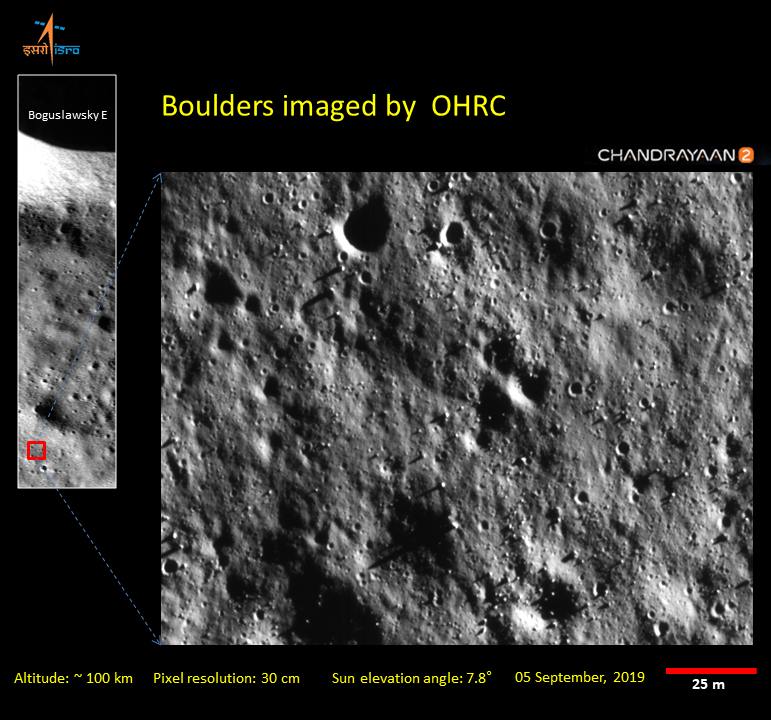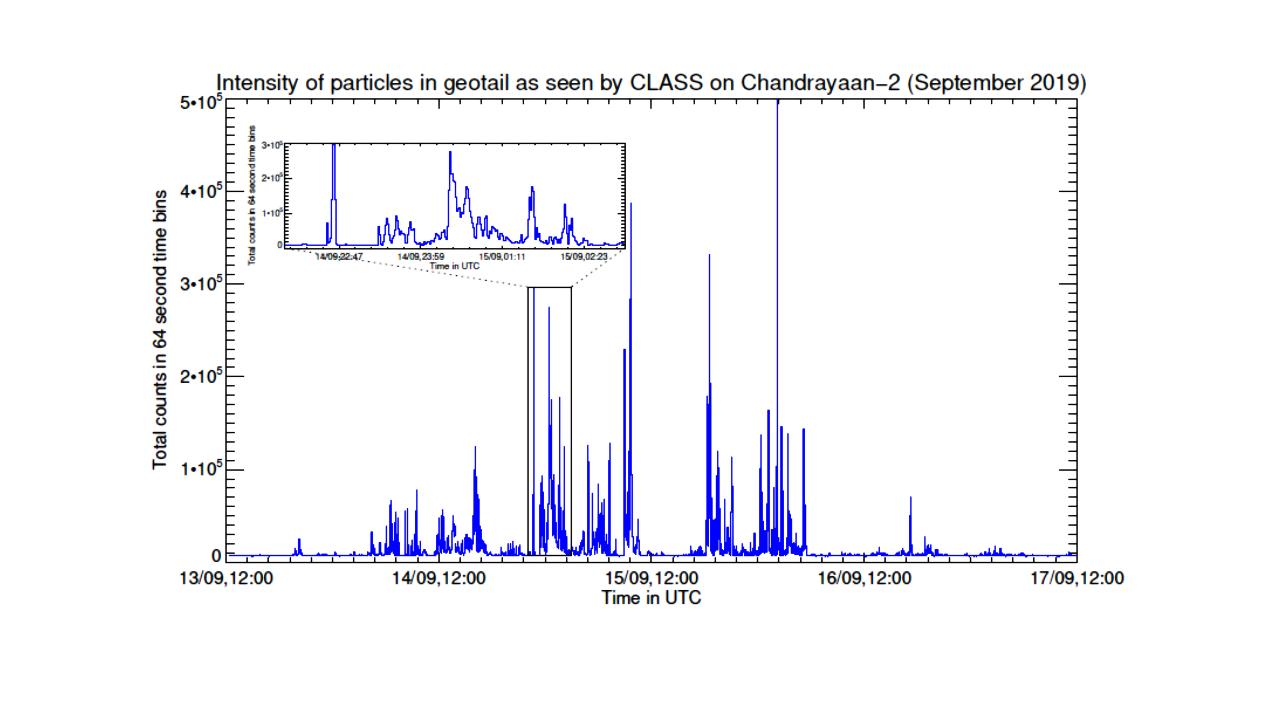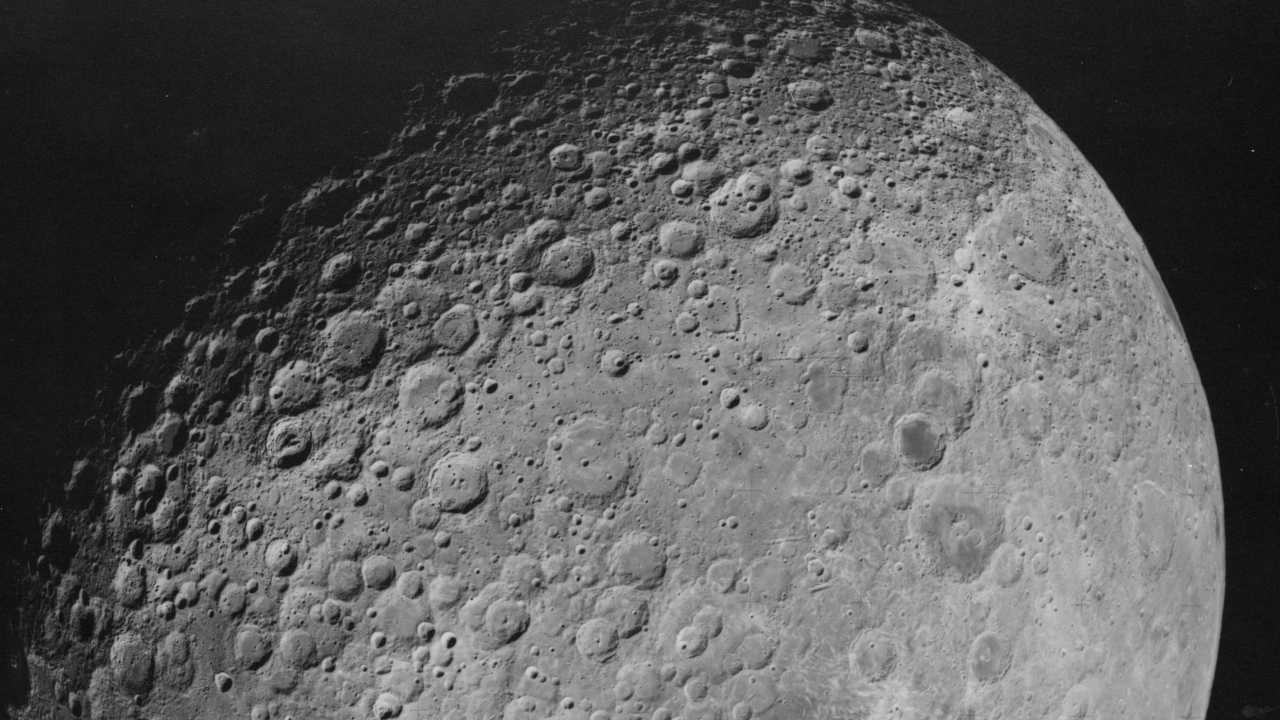After an uncomfortably long silence, the Indian Space Research Organisation (ISRO) has released images and the first scientific data from the Chandrayaan 2 mission, which is survived by the Orbiter. Captured by the Orbiter’s High-Resolution Camera (OHRC) from an altitude of ~100 kilometres, ISRO shared that the images are the highest resolution visuals ever taken of the Moon.
The image, acquired at 4.38 IST on 5 September, reveals part of the Boguslawsky E Crater in the South Polar region (named after German astronomer Palon H Ludwig Boguslawsky) and its immediate surroundings. ISRO also annotated the image with details about the crater, like its diameter (14 km) and depth (3 km). [caption id=“attachment_7470631” align=“alignnone” width=“771”] Images of the moon’s surface as seen by the Orbiter’s High-Resolution Camera (OHRC) on 5 September. Image: ISRO[/caption] [caption id=“attachment_7470641” align=“alignnone” width=“771”]
 Closeup images of the moon’s surface captured by the Chandrayaan 2 Orbiter’s High-Res Camera (OHRC). Image: ISRO[/caption] [caption id=“attachment_7470651” align=“alignnone” width=“771”]
Closeup images of the moon’s surface captured by the Chandrayaan 2 Orbiter’s High-Res Camera (OHRC). Image: ISRO[/caption] [caption id=“attachment_7470651” align=“alignnone” width=“771”] Closeup of of boulders on the moon’s surface, captured by the Chandrayaan 2 Orbiter’s High-Res Camera (OHRC). Image: ISRO[/caption] These images aren’t all that has kept the orbiter and ISRO busy in the month since the mission’s failed soft-landing. Also collected by the Orbiter’s instruments was data on the diversity of elements in the lunar soil. This,
ISRO clarified, was best done when a solar flare is in progress. The Sun emits a continuous stream of protons and electrons into the solar system in a phenomenon called ‘solar wind’. This burst of plasma — a high-speed cocktail of electrons, protons and high-energy particles — is released from the upper atmosphere of the Sun (the corona), and accelerated to dizzying speeds after it escapes the corona by the Sun’s magentic field. This plasma can travel far and wide across the solar system, and is also responsible for the “interplanetary magnetic field” (IMF), or extending the Sun’s magnetic field out among our system’s planets. [caption id=“attachment_6869461” align=“alignnone” width=“1280”]
Closeup of of boulders on the moon’s surface, captured by the Chandrayaan 2 Orbiter’s High-Res Camera (OHRC). Image: ISRO[/caption] These images aren’t all that has kept the orbiter and ISRO busy in the month since the mission’s failed soft-landing. Also collected by the Orbiter’s instruments was data on the diversity of elements in the lunar soil. This,
ISRO clarified, was best done when a solar flare is in progress. The Sun emits a continuous stream of protons and electrons into the solar system in a phenomenon called ‘solar wind’. This burst of plasma — a high-speed cocktail of electrons, protons and high-energy particles — is released from the upper atmosphere of the Sun (the corona), and accelerated to dizzying speeds after it escapes the corona by the Sun’s magentic field. This plasma can travel far and wide across the solar system, and is also responsible for the “interplanetary magnetic field” (IMF), or extending the Sun’s magnetic field out among our system’s planets. [caption id=“attachment_6869461” align=“alignnone” width=“1280”] A constant, invisible stream of solar material streams out from the Sun, shown here in an artist’s rendering. Image: NASA[/caption]
Solar wind and the Earth’s geotail
For ISRO, solar wind episodes also presented an opportunity. The Sun’s plasma, which has charged particles embedded in the far-reaching magnetic field of the Sun, moves at whopping speeds of a few hundred kms per second. Along the way, this plasma interacts with planets and space rocks — the Earth and Moon included. Thankfully, we Earthlings are spared from the wrath of solar wind by the Earth’s own, fairly powerful magnetic field, which deflects charged particles with ease. This interaction created a magnetic envelope around Earth, much like a shield, called the magnetosphere. [caption id=“attachment_7470971” align=“alignnone” width=“1280”] An illustration of how the magentosphere, solar wind and geotail interact with one another. Image: NASA[/caption] Earth’s magnetosphere isn’t an even layer enveloping the planet like the atmosphere is — it is three to four times the Earth’s radius (extending ~22,000 km from the surface) on the side of the planet facing the Sun. This also creates a long tail (similar to a comet’s tail) on the opposite side, which is long enough to extend past the Moon’s orbit. Every 29 days, the Moon experiences six days (often accompanied by a Full Moon) where it falls under the geotail’s influence. ISRO has also timed the orbits of the Chandrayaan 2 orbiter so it can cross this geotail and study how it behaves hundreds of thousands of kilometers from the Earth. This is the first scientific data collected by the Chandrayaan 2 mission. [caption id=“attachment_7471041” align=“alignnone” width=“1280”]
 Data from the CLASS instrument on Chandrayaan 2 shows the intensity of particles in the Earth’s geotail in September 2019. Image: ISRO[/caption]
Data from the CLASS instrument on Chandrayaan 2 shows the intensity of particles in the Earth’s geotail in September 2019. Image: ISRO[/caption]
‘Flash photography’ to illuminate elements
The CLASS instrument on Chandrayaan 2 is designed to pick up signatures of elements in the lunar soil. These signatures are observed very well when solar flares on the Sun send X-rays sweeping across the solar system. Rich source of X-rays that solar flares are, they illuminate the Moon’s surface as they strike it. This prompts the elements to absorb these X-rays and emit a unique spectrum of light basis which element it is. These “secondary X-ray emissions” can be detected by Chandrayaan 2’s CLASS instrument.
This “flash photography” technique needs prior planning to coincide with events dictated by the Sun. CLASS, in its first few days of observation, could detect charged particles and the variations in its intensity during its first pass through the geotail in September. Detailed studies in the mission’s future and observations from other space missions will help unravel the “dance of electrons to the music of magnetic fields” around Moon, ISRO said.
The mission’s lander Vikram and rover Pragyan, which crash-landed on the moon during a soft-landing attempt on 7 September, continue to be incommunicado with ISRO.


)
)
)
)
)
)
)
)
)



